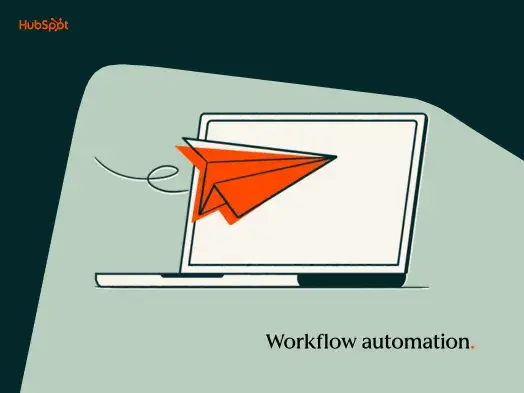One technology improvement has made marketers’ lives abundantly easier, however — marketing automation. This guide will walk you through the ins and outs of marketing automation, including:
Let’s dive in.
If you’ve ever done some midnight shopping (ahem, like me) and immediately received a confirmation email, you’ve been met with marketing automation. You didn’t think there was a poor guy sitting behind his computer at 1:00 AM waiting for new purchases to come through, did you?
No, that online store likely has some pre-written and scheduled email automations ready to go out when their customers complete certain tasks on their website. We’ll talk more about email marketing automation below.
Other marketing automations include social media, advertising, and SMS marketing automation, as well as internal automations that help you manage and triage marketing tasks.
Nearly 70% of marketing leaders are currently using a marketing platform. Of those who are automating marketing, 23% are automating their content delivery.
Marketing automations can certainly make life easier, but it shouldn’t replace human touch. As I said in the introduction, a recent increase in technology has been met with increased or changed consumer expectations. Marketing automation is no exception — consumers appreciate the timeliness and thoughtfulness of automation, but they also can also read between the lines of bot-written copy or stale imagery.
Marketing automation should complement your current marketing efforts, not replace them.
What is marketing automation primarily used for?
Marketing automation is primarily used to mechanize and automate otherwise manual marketing tasks like sending emails, posting social media messages, collecting information, and managing internal tasks.
Benefits of Marketing Automation
There are countless benefits of marketing automation. A few I’d like to highlight include:
- Efficiency: Wasted time is a marketer’s nightmare. Marketing automation can help you complete repeatable tasks in an efficient and effective manner.
- Nurtured leads: It takes a lot of time and energy to effectively nurture every individual lead; however, it’s too important not to. Marketing automation allows you to nurture your leads on a mass scale while still personalizing each lead’s experience with your brand. 70% of the companies report that the most important benefit of automation technology is better-targeted customer communication.
- Increased revenue: The more you nurture your leads, the more leads that’ll likely convert to users. Marketing automation can result in increased revenue as more leads become paying customers.
- Better reporting: Marketing automation streamlines important marketing tasks and allows you to review and analyze your activity and its results.
Types of Marketing Automation
Marketing automation can take many forms. Let’s unpack the different types of automation and how you can use them in your marketing.
Email Marketing Automation
Email marketing automation is perhaps the most common use case for automation. From welcome emails to post-purchase emails and re-engagement emails, there’s a lot that goes into email marketing. Without email marketing automations and workflows, email would be an otherwise very manual process.
Email automation is typically triggered by time or action. Time-based emails are sent on certain occasions, such as a customer’s birthday (don’t you love those free birthday drinks from Starbucks?) or a holiday (Black Friday discounts, anyone?).
Action-based emails are a bit more involved. These automated emails are triggered by actions taken by a website visitor, lead, or customer who then receives an email or series of emails related to that particular action.
Let’s return to my midnight shopping example. Instead of completing my purchase and receiving the subsequent confirmation email, let’s say I exit the site with items still in my cart—and within 30 minutes, I receive an email reminding me about the forgotten items. This is called an “abandoned cart” email, and many online stores deploy them in hopes that shoppers return and complete their purchases. This is an example of an action-based email marketing automation.

Email automation campaigns are among the top three tactics used by email marketers to improve performance, and email marketing automation has many benefits. The best one (in my opinion) is how it saves precious time and energy by otherwise priceless tasks. Automated emails can help you generate leads and increase revenue, but that doesn’t mean your marketing team has to spend all their time sending and monitoring them. That’s what marketing automation is for.
Learn everything you need to know about email marketing in our free HubSpot Academy course.
Digital Marketing Automation
Although email marketing is a common use case for marketing automation, it’s not the only one. Let’s talk about other forms of digital marketing automation (both external and internal).
Social Media Marketing Automation
Anyone who works in marketing knows how time-intensive social media marketing can be. If you’re going to do it right, you’ve got to do, well, nonstop. Thankfully, marketing automation can help. Tools like HubSpot and Hootsuite allow you to schedule content, set social media monitoring filters, and even automate the response process — although this should never replace genuine, human interaction with your followers and customers.
Advertising Automation
You’ve heard of retargeting, yes? Now … could you imagine having to go into every advertising platform and change the copy, graphics, and timing based on each customer’s individual actions or behavior? Whew, that’d be a lot. Retargeting is an example of advertising automation, as it automatically shifts and smartens its strategy in response to consumer behavior. If a customer visits your website, your retargeting automation will respond by displaying relevant ads on the sites they browse next.

Mobile Marketing Automation
As SMS marketing becomes more popular and effective, companies are adding mobile marketing to their marketing automation tool belts. Like emails, text messages can also be automated and triggered based on time or actions, and they tend to have a higher (and faster) open rate than emails.
CRM with Marketing Automation
Ah, the CRM —a marketer’s best friend. Thankfully, your CRM and marketing automation can go hand-in-hand. A simple update in your database can trigger a whole host of internal tasks, including lead scoring and alerting your sales team to new prospects. You can also use your CRM to trigger email workflows, either based on user data or user actions.

Marketing Automation Software
As a marketer, your marketing technology stack may or may not be your best friend … I know mine sure is.
Do you have a favorite tool or two? Let me guess — a marketing automation software (if you’re currently using one) just crossed your mind.
I don’t blame you. These tools sure make our lives easier and our customers happier. If you’re looking for new tools to add to your list, or you’re wanting to check out marketing automation for the first time, take a look at the marketing automation software tools we’ve compiled in this article. Here are a handful of of my favorites:
HubSpot
The HubSpot CRM, as mentioned above, provides many marketing automation features. As a standalone tool, HubSpot’s marketing automation allows you to automate a variety of tasks, from setting up simple email workflows to building a complex network of rules to target users with tailored emails, live chats, and more.
Drip
Drip specializes in e-commerce marketing automation. It’s mostly used for email marketing and provides email automation workflows, multi-channel marketing, full campaigns, and more.
ManyChat
ManyChat allows you to extend your marketing automation strategy beyond email. Use this tool to build a smart bot to engage with prospects and customers on Facebook Messenger and over SMS. While your marketing automation shouldn’t replace a human touch, ManyChat can help you get the conversation started with prospects — it also captures information from prospects and adds it to your CRM.
Sprout Social
I had to include at least one social media marketing automation tool on this shortlist. Sprout Social can help lighten the load of manual social media tasks — responding to messages, tracking engagement, and measuring audience sentiment. Moreover, Sprout Social provides easy onboarding documentation and resources so you can hit the ground running.
Marketing Automation Strategy
Your marketing automation strategy should vary depending on what tools you use and what goals you set. For example, if you choose to use HubSpot to nurture leads that download a free ebook, your strategy would focus on converting those leads using information relevant to why they perhaps downloaded the ebook—and how your product or service could help meet those needs.
Regardless of your marketing automation strategy, however, make note of these few marketing automation best practices:
- Know your audience. You can’t create personalized marketing — whether automated or not — without knowing what your audience’s pain points are and how you can meet them. Build your buyer personas to get to know your audience before building your marketing automation workflows.
- Know your customer journey. A key determinant of successful marketing automation is meeting your lead wherever they are. You can’t do this unless you know their journey to become your customer. Map out your customer journey and match your marketing automation to those lead stages.
- Review on a regular basis. Although marketing automation is pretty hands-off, it is not a one-and-one strategy. Review your marketing automation workflows on a monthly, quarterly, and yearly basis. Your automation should change as your business, products, and customers do.
Check out this blog post for more marketing automation best practices.
Automate Your Marketing to Grow Better
Marketing automation may seem like a lot to learn upfront … but imagine what it’ll feel like to kick back and relax once you’ve got everything in place. OK, maybe not relax, but marketing automation will certainly help you shorten that to-do list.
From email marketing to advertising and retargeting to internal tasks, marketing automation can help you save time, energy, and money — and make your customers’ lives easier and happier. It truly is a marketer’s best friend.
Marketing Automation





%20(6).png)



![Email Automation: How to Set Up Automated Workflows [Data]](https://53.fs1.hubspotusercontent-na1.net/hubfs/53/email%20automation.jpg)
![Drip Marketing: Everything You Need to Know [+ 3 Examples]](https://53.fs1.hubspotusercontent-na1.net/hubfs/53/drip-marketing_2.webp)

